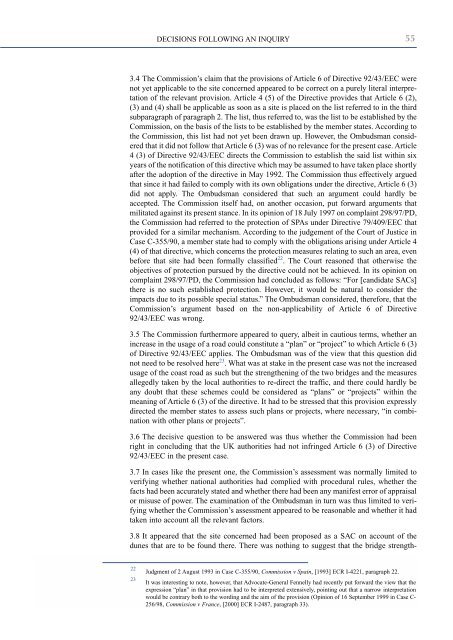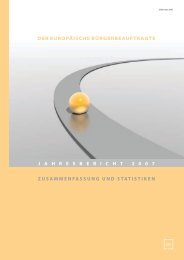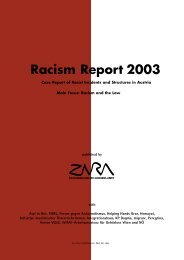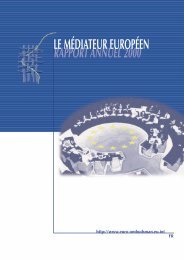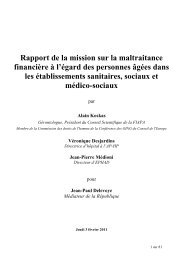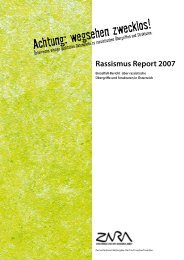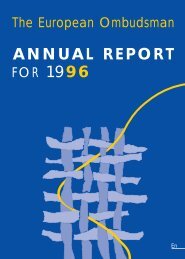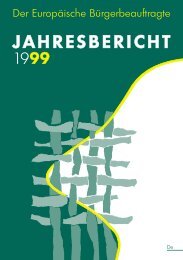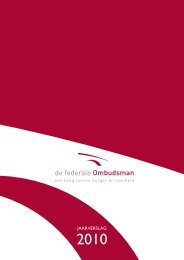Annual report 2000
Annual report 2000
Annual report 2000
Create successful ePaper yourself
Turn your PDF publications into a flip-book with our unique Google optimized e-Paper software.
DECISIONS FOLLOWING AN INQUIRY 553.4 The Commission’s claim that the provisions of Article 6 of Directive 92/43/EEC werenot yet applicable to the site concerned appeared to be correct on a purely literal interpretationof the relevant provision. Article 4 (5) of the Directive provides that Article 6 (2),(3) and (4) shall be applicable as soon as a site is placed on the list referred to in the thirdsubparagraph of paragraph 2. The list, thus referred to, was the list to be established by theCommission, on the basis of the lists to be established by the member states. According tothe Commission, this list had not yet been drawn up. However, the Ombudsman consideredthat it did not follow that Article 6 (3) was of no relevance for the present case. Article4 (3) of Directive 92/43/EEC directs the Commission to establish the said list within sixyears of the notification of this directive which may be assumed to have taken place shortlyafter the adoption of the directive in May 1992. The Commission thus effectively arguedthat since it had failed to comply with its own obligations under the directive, Article 6 (3)did not apply. The Ombudsman considered that such an argument could hardly beaccepted. The Commission itself had, on another occasion, put forward arguments thatmilitated against its present stance. In its opinion of 18 July 1997 on complaint 298/97/PD,the Commission had referred to the protection of SPAs under Directive 79/409/EEC thatprovided for a similar mechanism. According to the judgement of the Court of Justice inCase C-355/90, a member state had to comply with the obligations arising under Article 4(4) of that directive, which concerns the protection measures relating to such an area, evenbefore that site had been formally classified 22 . The Court reasoned that otherwise theobjectives of protection pursued by the directive could not be achieved. In its opinion oncomplaint 298/97/PD, the Commission had concluded as follows: “For [candidate SACs]there is no such established protection. However, it would be natural to consider theimpacts due to its possible special status.” The Ombudsman considered, therefore, that theCommission’s argument based on the non-applicability of Article 6 of Directive92/43/EEC was wrong.3.5 The Commission furthermore appeared to query, albeit in cautious terms, whether anincrease in the usage of a road could constitute a “plan” or “project” to which Article 6 (3)of Directive 92/43/EEC applies. The Ombudsman was of the view that this question didnot need to be resolved here 23 . What was at stake in the present case was not the increasedusage of the coast road as such but the strengthening of the two bridges and the measuresallegedly taken by the local authorities to re-direct the traffic, and there could hardly beany doubt that these schemes could be considered as “plans” or “projects” within themeaning of Article 6 (3) of the directive. It had to be stressed that this provision expresslydirected the member states to assess such plans or projects, where necessary, “in combinationwith other plans or projects”.3.6 The decisive question to be answered was thus whether the Commission had beenright in concluding that the UK authorities had not infringed Article 6 (3) of Directive92/43/EEC in the present case.3.7 In cases like the present one, the Commission’s assessment was normally limited toverifying whether national authorities had complied with procedural rules, whether thefacts had been accurately stated and whether there had been any manifest error of appraisalor misuse of power. The examination of the Ombudsman in turn was thus limited to verifyingwhether the Commission’s assessment appeared to be reasonable and whether it hadtaken into account all the relevant factors.3.8 It appeared that the site concerned had been proposed as a SAC on account of thedunes that are to be found there. There was nothing to suggest that the bridge strength-2223Judgment of 2 August 1993 in Case C-355/90, Commission v Spain, [1993] ECR I-4221, paragraph 22.It was interesting to note, however, that Advocate-General Fennelly had recently put forward the view that theexpression “plan” in that provision had to be interpreted extensively, pointing out that a narrow interpretationwould be contrary both to the wording and the aim of the provision (Opinion of 16 September 1999 in Case C-256/98, Commission v France, [<strong>2000</strong>] ECR I-2487, paragraph 33).


